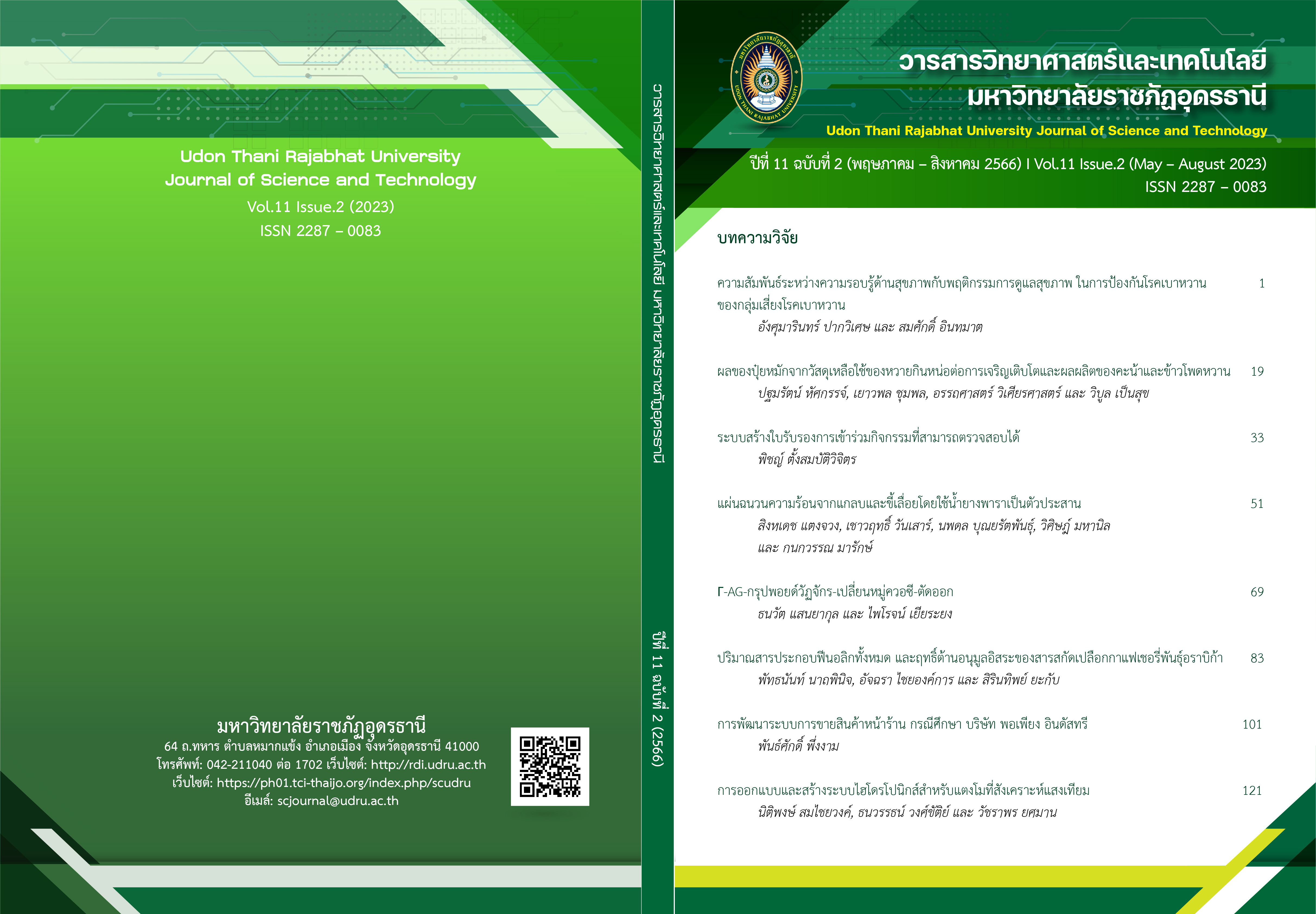ปริมาณสารประกอบฟีนอลิกทั้งหมด และฤทธิ์ต้านอนุมูลอิสระ ของสารสกัดเปลือกกาแฟเชอรี่พันธุ์อราบิก้า
Main Article Content
บทคัดย่อ
งานวิจัยนี้มีวัตถุประสงค์ เพื่อวิเคราะห์หาปริมาณสารประกอบฟีนอลิกทั้งหมด และฤทธิ์ต้านอนุมูลอิสระจากสารสกัดเปลือกกาแฟเชอรี่พันธุ์อราบิก้า ได้ศึกษาปริมาณสารประกอบฟีนอกลิกและฤทธิ์ต้านอนุมูลอิสระด้วยวิธี DPPH และ FRAP จากเปลือกสด และแบบแห้งด้วยเอทานอล 95% หรือน้ำร้อนเป็นเวลา 7 วัน ที่อัตราส่วนน้ำหนักเปลือกแห้งต่อตัวทำละลายที่ 1:10 ผลการวิจัยพบว่าการสกัดเปลือกแห้งด้วยน้ำร้อนจะได้สารประกอบ ฟีนอลิกทั้งหมดมากที่สุด ลำดับถัดมาคือเปลือกแห้งด้วยเอทานอล เปลือกสดด้วยเอทานอล และเปลือกสดด้วยน้ำร้อน ตามลำดับ โดยมีสารประกอบฟีนอลิกทั้งหมดในช่วง 0.39-2.83 มก.กรดแกลลิกต่อ ก.เปลือกกาแฟ สำหรับฤทธิ์ต้านอนุมูลอิสระ พบว่า สารสำคัญในเปลือกกาแฟเชอรี่มีฤทธิ์ต้านอนุมูลอิสระด้วยวิธี DPPH มากกว่า FRAP โดยมีค่า IC50 อยู่ที่ 143 มค.ก.กรดแอสคอร์บิกต่อ มล. สารสกัดเปลือกแห้งด้วยน้ำร้อนมีค่า DPPH สูงสุดที่ 821 มค.ก.กรดแอสคอร์บิกต่อ มล. สำหรับ FRAP การสกัดด้วยน้ำร้อนมีค่ามากกว่าการสกัดด้วยเอทานอล และเปลือกแห้งมีค่ามากกว่าเปลือกสด โดยสารสกัดเปลือกแห้งด้วยน้ำร้อนมีค่ามากที่สุดที่ 69.33 มค.ก.แอสคอร์บิกต่อ ก.เปลือกกาแฟ หรือ 122.25 มค.ก.สมมูลเฟอรัส ซัลเฟตต่อ ก.เปลือกกาแฟ
Article Details
เอกสารอ้างอิง
ชุติมณฑน์ พลอยประดับ, พุทธพร เจียมศุภกิตต์ และ นิรมล ปัญญ์บุศยกุล. (2553). ฤทธิ์การต้านออกซิเดชั่นของส่วนต่างๆ ของผลกาแฟอาราบิก้า และเปลือกกาแฟ. วารสารวิทยาศาสตร์เกษตร, 41(3/1), 577-580.
พัทธชัย ปิ่นนาค, ธัญญ์นรี จิณะไชย, สุพิชญา เกษร และ อาลิตา มาคูณ. (2563). ปริมาณสารต้านอนุมูลอิสระและฤทธิ์ต้านอนุมูลอิสระในเปลือกกาแฟเชอร์รี่และดอกกาแฟ ในระบบวนเกษตรของจังหวัดอุตรดิตถ์. วารสารวิชาการวิทยาศาสตร์และวิทยาศาสตร์ประยุกต์, 1, 61 – 70.
ไพโรจน์ วิริยจารี. (2550). การพัฒนากาแฟพันธุ์อาราบิก้าจากผลพลอยได้ของกระบวนการแปรรูปกาแฟระยะที่ 1: การผลิตเมล็ดกาแฟดิบด้วยเทคโนโลยีทางเอนไซม์. ภาควิชาเทคโนโลยีการพัฒนาผลิตภัณฑ์ มหาวิทยาลัยเชียงใหม่.
สมหมาย ปัตตาลี. (2551). การศึกษาคุณภาพของน้ำหมักชีวภาพที่ผลิตจากผลมะหลอด. (วิทยานิพนธ์ปริญญามหาบัณฑิต, มหาวิทยาลัยศรีนครินทรวิโรฒประสานมิตร).
สิตา ทิศาดลดิลก และ เอื้อมพร รัตนสิงห์. (2562). ฤทธิ์ต้านออกซิเดชัน และปริมาณสาร ประกอบฟีนอลิกทั้งหมดของสารสกัดหยาบจากมะตาด. วารสารวิจัยและพัฒนา วไลยอลงกรณ์ในพระบรมราชูปถัมภ์ สาขาวิทยาศาสตร์และเทคโนโลยี, 14(3), 104-116.
สำนักส่งเสริมและจัดการสินค้าเกษตร. (2562). กาแฟ. สืบค้นเมื่อวันที่ 24 เมษายน 2564, จาก http://www.agriman.doae.go.th/home/news/2562/33-34.pdf.
อชิดา จารุโชติกมล, ปวิตรา พูลบุตร, คะนึงนิตย์ คาภากุล, วราภรณ์ ยุบลพาส, ภูริตา นาสิงบุตร, กนกนุช จันทะคาม, อาภาภิชย์ บัวเขียว, เกสราภรณ์ งามญาติ และ
ฐิติพร พลศรี. (2562). ฤทธิ์ต้านอนุมูลอิสระของสารสกัดน้ำร้อนของยอดอ่อนฟักข้าว. วารสารวิทยาศาสตร์และเทคโนโลยี, 27(3), 473-484.
AOAC. (1990). Official Method of Analysis of the Association of Official Analytical Chemists. No. 934.06, AOAC, Arlington.
Hamama, A. A., & Nawar, W. W. (1991). Thermal decomposition of some phenolic antioxidants. Journal of Agricultural and Food Chemistry, 39(6), 1063–1069.
Hillkoff. (2564). COC #1 cider of coffee. [Online]. Retrieved April 24, 2021, from https://hillkoff.org/coc-1-cider-of-coffee.
Hirano, R., Sasamoto, W., Matsumoto, A., Itakura, H., Igarashi, O., & Kondo, K. (2001). Antioxidant ability of various flavonoids against DPPH radicals and LDL oxidation. Journal of Nutritional Science and Vitaminology, 47(5), 357-362.
Kao, Y. H., Chang, H. H., Lee, M. J., & Chen, C. L. (2006). Tea, obesity, and diabetes. Molecular Nutrition & Food Research, 50(2), 188-210.
Liu, J., Gen, J., Yu, Y., Zhu, S., Yin, L., & Cheng, Y. (2016). Effect of laboratory-scale decoction on the antioxidative activity of Zhenjiang Aromatic Vinegar: Th contribution of melanoidins. Journal of Functional Foods, 21, 75-86.
Nguyen, T. M. T., Cho, E. J., Oh, T., Song, C. H., Funada, R., & Bae, H. J. (2019). Use of coffee flower as a novel resource for the production of bioactive compounds, melanoidins, and bio-sugars. Food Chemistry, DOI: 10.1016/ j.foodchem.2019.125120.
Pekal, A., & Pyrzynska, K. (2004). Evaluation of aluminium complexation reaction for flavonoid content assay. Food analysis, 7, 1776-1782.
Rains, T. M., Agarwal, S., & Maki, K. C. (2011). Antiobesity effects of green tea catechins: a mechanistic review. Journal of Nutritional Biochemistry, 22(1), 1-7.
Rosillo, M., Alarcon, C., & Sanchez, M. (2016). An update on dietary phenolic compounds in the prevention and management of rheumatoid arthritis. Chemical Science, 7, 2943-2969.
Thomas, J. B. (2012). A Comparative study of the Antioxidant activity (DPPH), Total flavonoid, Total Tannin, Total polyphenol levels in plant extracts of the Annona muricata, Ribes nigrum and Manilkara zapota. International Journal of Scientific and Research Publications. 6(9), 490-494.
Yang, J., Chen, J. F., Zhao, Y. Y., & Mao, L. C. (2010). Effects of drying processes on the antioxidant properties in sweet potatoes. Agricultural Sciences in China, 9(10), 1522–1529.


